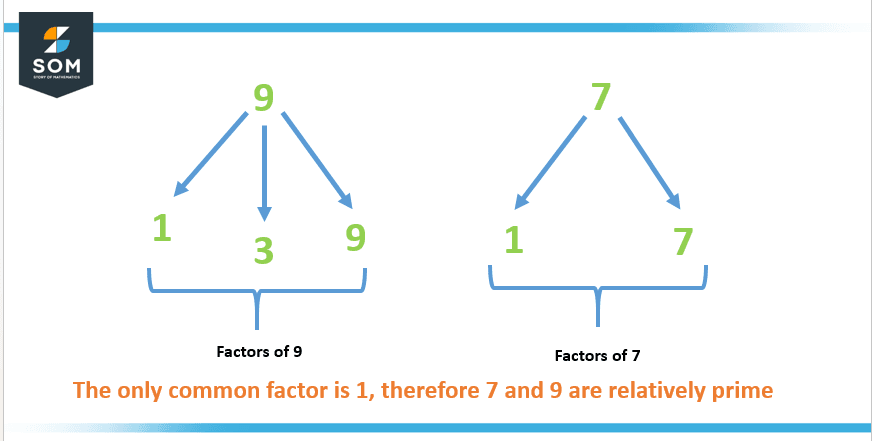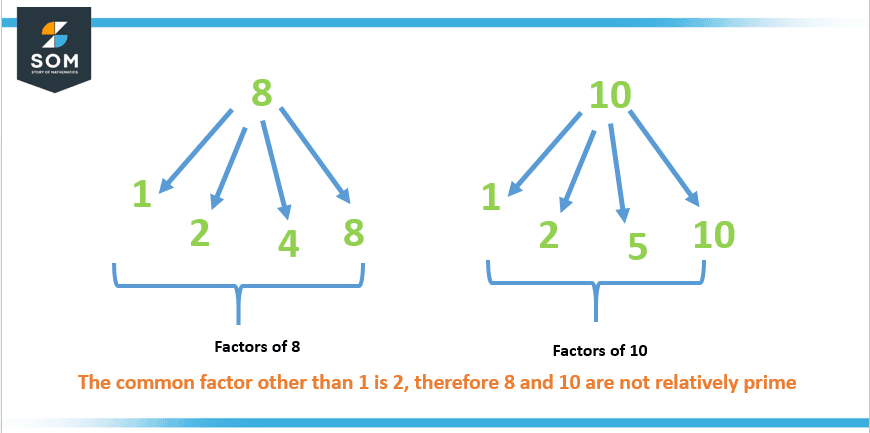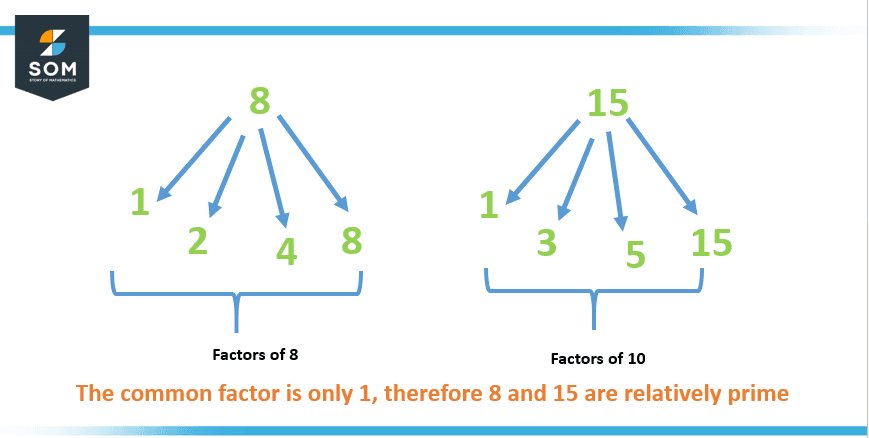JUMP TO TOPIC
Relatively Prime|Definition & Meaning
Definition
Two numbers are relatively prime (or co-prime/mutually prime) if they share no common factors apart from 1. In other words, no number can wholly divide both of them. For example, even though both 9 (factors: 1, 3, 9) and 14 (factors: 1, 2, 7, 14) are not prime numbers, they are relatively prime because they have no common factors other than 1.
The concept of a relatively prime number is elaborated in Figure 1 below:

Figure 1: Concept of relatively prime numbers
If there isn’t an integer bigger than one that divides two integers, then those two numbers are substantially prime (or co-prime) (that is, their greatest common divisor is one). For instance, 12 and 13 are relatively prime, but 12 and 14 are not. If a list of integers cannot be divided into equal parts, the list is (mutually) relatively prime.
For instance, the numbers 30, 42, 70, and 105 are all relatively prime to each other (but not pairwise relatively prime).
This definition can be applied to multiple additional situations. For instance, if there is no non-constant polynomial that separates two polynomials with integer coefficients, they are supposed to be relatively prime.
If the only positive integer that splits both two integers a and b equally is 1, then the two numbers are co-prime, relatively prime, or mutually prime.
As a result, every prime integer that divides a does not divide b, and the opposite is also true. In this case, their greatest common divisor (GCD) is equal to 1. One claims that a and b are co-prime or that a is prime to b.
Although none of the two 8 and 9 is a prime number when taken separately because 1 is their only shared factor, they are co-prime numbers. However, since 6 and 9 are both divisible by 3, they are not co-prime. A reduced fraction has a co-prime numerator and denominator by definition.
Notation and Testing
For the relatively prime numbers a and b, the standard notation is GCD (a, b) = 1 and (a, b) = 1. Ronald Graham, Donald Knuth, and Oren Patashnik suggested using the notation a⊥b to denote that variables a and b are relatively prime and the term “prime” in place of co-prime in their 1989 textbook Concrete Mathematics (as in a is prime to b).
The Euclidean algorithm and its quicker iterations, such as the binary GCD algorithm or Lehmer’s GCD algorithm, provide a quick approach to detecting whether two numbers are co-prime. The Euler function also referred to as the Euler phi function, φ(n), provides the total number of integers that are co-prime with a positive integer n, ranging from 1 to n.
If all of an integer set’s components have unique positive factors other than 1, the set is said to be co-prime. Pairwise co-prime, which requires that a and b are co-prime for each pair (a, b) of distinct integers in the set, is a more substantial requirement on a set of integers.
The set “2, 3, 4” is co-prime, but since 2 and 4 are not substantially prime, it is not pairwise co-prime.
What Are Relatively Prime Numbers?
Two numbers, G and H, are called relatively prime if the only component they have in common is 1. The pair (a, b), in this instance, is considered to be relatively prime.
These figures don’t necessarily have to be prime numbers. Additionally, two composite numbers, such as 9 and 10, can be substantially primes. Co-prime or mutually prime numbers are other names for relatively prime numbers. The identification of relatively prime numbers has been elaborated below in Figure 2.

Figure 2: Identifying relatively prime numbers
How To Find Relatively Prime Numbers?
Finding the HCF of the numbers allows us to determine whether or not two numbers are relatively prime. The two numbers are referred to as relatively primes if the HCF is 1. List all the contributing elements, then choose the one with the highest common factor between the two integers to determine their HCF.
An example of finding a relatively prime number is shown in Figure 3 below.

Figure 3: Example for finding relatively prime numbers
Relatively Prime Numbers Properties
A few properties related to relatively prime numbers are listed below:
When two reasonably prime numbers are combined, the HCF (Highest Common Factor) is always 1. For instance, 5 and 7 are both considered to be relatively prime numbers, hence HCF (5, 7) = 1.
The result of two reasonably prime numbers is always the LCM or least common multiple. Assuming a and b are the two numbers, the relationship between their HCF and LCM is HCF (g, h) × LCM (g, h) = g * h. The result of the multiplication of numbers is identical to the LCM since the numbers are relatively prime and their HCF is 1. Examples of relatively prime numbers include 3 and 5. Consequently, LCM = 3× 5 = 15.
Every time two relatively prime numbers are added together, their product is also relatively prime. Examples of relatively prime numbers include 3 and 5. Here, 3 + 5 = 8 and 3 × 5 = 15. are both relatively prime numbers. 8 and 15 only share 1 as a factor in common.
Every pair of prime numbers is always nearly prime. For instance, the only element that 7 and 11 have in common is 1, and both of these numbers are prime.
Due to the fact that prime numbers can be divided by one another or by themselves, they are more prime than any other number. Any prime number will therefore be relatively prime if we combine it with other numbers because their common factor is 1. For instance, 11 and 15 are relatively prime numbers because they have the same component, which is 1. Factors 11 are 1 and 11 and factors 15 are 1, 3, 5, and 15.
Two consecutively occurring numbers are always relatively prime. For example, 23 and 24 are two relatively prime consecutively occurring numbers.
Important Notes
Some of the key points regarding relatively prime that we read in this essay are listed below. Look at that!
Two numbers that are prime are also relatively prime.
Two numbers that occur in consecutive order are also relatively prime.
A number that is prime is also relatively prime in comparison to other numbers.
It is not possible that two even numbers become relatively prime due to the fact that the number 2 is a factor of all even integers.
Solved Examples
Example 1
Check whether the following numbers are relatively prime. a) 18 and 19, b) 23 and 25
Solution
a) 18 and 19
Factors of 18 = 1,2,4,8,16
Factors of 19 = 1, 19
Note that there is no common factor other than 1 in the factors list of 18 and 19. Therefore, these numbers are relatively prime. On the other side, these numbers are consecutive, and we know that fact that every consecutive number is relatively prime.
b) 23 and 25
Factors of 23 = 1, 23
Factors of 25 = 1, 5, 25
The only common factor is 1. Therefore, 23 and 25 are relatively prime.
Example 2
If the result of the multiplication of two numbers that are relatively prime is 87, calculate their LCM.
Solution
As we know the fact that when the two numbers are relatively prime, their HCF=1 and
Least Common Multiple * HCF = Product of the two numbers
Least Common Multiple * 1 = 87
Least Common Multiple = 87
That is the required result.
Example 3
Considering that 57 and 97 are both relatively prime numbers, Sophia is asked to determine their HCF. Are you able to help her with this?
Solution
Given that 57 and 97 are both relatively prime numbers, their only factor in common is 1. Therefore their HCF is 1.
Example 4
Check whether the following pair of numbers are relatively prime or not a) 5 and 11; b) 12 and 14.
Solution
a) 5 and 11
On factorization, we see that the factors of 5: 1, 5, and factors of 11 are: 1, 11.
Note that the only common factor among these numbers is 1. Therefore, (5, 11) is relatively prime.
b) 12 and 14
On factorization, we can see that the factors of 8 are 1, 2, 4, and 8, and the factors of 10 are 1, 2, 5, and 10. 1 and 2 are the only common factors among these numbers (8,10). so HCF (8, 10) = 2. Therefore, (8,10) is not relatively prime.
All images/mathematical drawings were created with GeoGebra.
